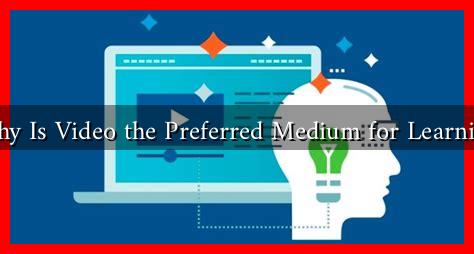-
Table of Contents
- Why Is Video the Preferred Medium for Learning?
- The Power of Visual Learning
- Engagement and Retention
- Key Factors Contributing to Engagement:
- Flexibility and Convenience
- Examples of Flexible Learning:
- Cost-Effectiveness
- Statistics on Cost-Effectiveness:
- Real-World Applications and Success Stories
- Conclusion
Why Is Video the Preferred Medium for Learning?
In an age where information is abundant and attention spans are dwindling, video has emerged as a dominant medium for learning. From online courses to educational YouTube channels, the visual format has transformed how we absorb information. This article explores the reasons behind the growing preference for video as a learning tool, supported by research, statistics, and real-world examples.
The Power of Visual Learning
Humans are inherently visual creatures. Research indicates that approximately 65% of the population are visual learners, meaning they retain information better when it is presented visually. Video combines visual elements with auditory cues, making it a powerful tool for enhancing understanding and retention.
Engagement and Retention
One of the most compelling reasons for the preference of video in learning is its ability to engage learners effectively. Studies show that learners are more likely to stay focused and retain information when it is delivered through video. According to a study by the University of California, Berkeley, students who watched video lectures scored significantly higher on assessments compared to those who relied solely on text-based materials.
Key Factors Contributing to Engagement:
- Dynamic Content: Videos can incorporate animations, graphics, and real-life examples that make learning more dynamic and relatable.
- Storytelling: Videos often use storytelling techniques that captivate audiences, making complex subjects easier to understand.
- Accessibility: With platforms like YouTube and educational websites, learners can access video content anytime and anywhere, catering to diverse learning environments.
Flexibility and Convenience
Video learning offers unparalleled flexibility. Learners can pause, rewind, and rewatch content at their own pace, allowing for a personalized learning experience. This is particularly beneficial for complex subjects that require more time to digest.
Examples of Flexible Learning:
- Online Courses: Platforms like Coursera and Udemy provide video-based courses that allow learners to study at their convenience.
- Flipped Classrooms: Educators are increasingly using video to flip traditional teaching methods, assigning video lectures as homework and using class time for interactive discussions.
Cost-Effectiveness
Video learning can also be more cost-effective than traditional educational methods. Producing video content can be less expensive than organizing in-person classes, especially when considering travel and accommodation costs. Additionally, once created, video content can be reused multiple times, maximizing its value.
Statistics on Cost-Effectiveness:
- A report from the Wainhouse Research indicates that organizations can save up to 50% on training costs by using video-based learning.
- According to a study by the Association for Talent Development, companies that utilize video training report a 60% increase in employee retention of information.
Real-World Applications and Success Stories
Numerous organizations and educational institutions have successfully integrated video into their learning strategies. For instance, the Khan Academy has revolutionized math education through its extensive library of instructional videos, helping millions of students worldwide. Similarly, companies like Google and IBM have adopted video training programs to enhance employee skills and knowledge.
Conclusion
In conclusion, the preference for video as a learning medium is driven by its ability to engage, retain, and accommodate diverse learning styles. With its flexibility, cost-effectiveness, and real-world applications, video has proven to be an invaluable tool in education and professional development. As technology continues to evolve, the role of video in learning will likely expand, making it an essential component of modern education.
As we move forward, embracing video as a primary learning medium can lead to more effective and enjoyable educational experiences for learners of all ages.


